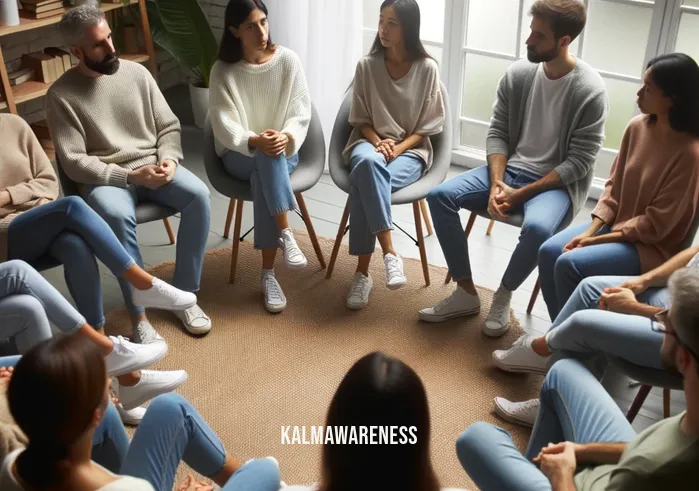Embracing the Calm: The Art of Non Reactivity
In today’s fast-paced world, the ability to remain calm and collected in the face of stress and provocation is more than just a skill—it’s a superpower. Welcome to the world of non reactivity, a principle that can transform the way you interact with life’s challenges and maintain your inner peace.
The Essence of Non Reactivity
At its core, non reactivity is about maintaining a balanced emotional state, regardless of external stimuli. It means not letting your emotions get hijacked by the ups and downs of daily life. Imagine being in a situation that would typically trigger anger, frustration, or anxiety. Instead of reacting impulsively, you pause, reflect, and choose a response that aligns with your values and well-being.
Why Non Reactivity Matters
Embracing non reactivity doesn’t mean you become emotionless or indifferent. Instead, it allows you to experience emotions without becoming overwhelmed by them. This approach fosters mental resilience and a deeper sense of contentment. When you’re not constantly reacting to every little thing, you can focus more on what truly matters, leading to improved relationships, productivity, and overall happiness.
The Role of Mindfulness in Non Reactivity
Mindfulness plays a pivotal role in developing non reactivity. It involves being fully present and aware of your thoughts and feelings without judgment. This heightened awareness makes it easier to recognize when you’re about to react impulsively and gives you the space to choose a more measured response. Incorporating mindfulness practices, such as meditation or mindful movement, into your daily routine can significantly enhance your ability to remain non reactive.
The Science Behind Non Reactivity
Research shows that non reactivity is linked to lower stress levels, better emotional regulation, and even improved brain function. By practicing non reactivity, you train your brain to respond rather than react, which can lead to a more fulfilling and less stressful life.
Cultivating Non Reactivity in Daily Life
To begin embracing non reactivity, start with small, everyday situations. Notice when you feel a strong emotional reaction bubbling up and take a moment to pause. Breathe deeply, acknowledge your feelings, and then decide how you want to respond. It’s a practice that gets easier with time and can make a significant difference in your overall well-being.
For those who struggle with this concept, it’s important to be patient with yourself. Remember, it’s about progress, not perfection. There are various resources available, such as mindful hypnobirthing or sustainable self-care strategies, to help guide you on this journey.
Transitioning to Further Exploration
As you explore the concept of non reactivity, consider how it can be applied in different areas of your life. What would change if you approached difficult conversations, work challenges, or personal goals with a non reactive mindset?
Reflect on this: How might mastering non reactivity reshape your relationships and self-perception? Stay tuned for the next part of our journey, where we delve deeper into applying non reactivity in specific life scenarios and overcoming common challenges associated with this practice.

Non Reactivity in Action: Real-Life Application
Building upon the foundation of understanding non reactivity, let’s delve into its practical application in everyday life. Non reactivity isn’t just a concept to understand; it’s a skill to be practiced and honed. This section explores how to apply non reactivity in various life scenarios, enhancing our ability to navigate challenges with poise and clarity.
Applying Non Reactivity in Personal Relationships
One of the most profound areas where non reactivity can make a significant impact is in our personal relationships. Consider a heated argument with a loved one. A reactive response might escalate the situation, but a non reactive approach, where you listen, process, and respond thoughtfully, can lead to more constructive outcomes. It’s about choosing understanding over impulsiveness.
“Non reactivity in relationships is not about suppressing emotions, but about responding to them in a way that fosters understanding and empathy.”
The Role of Empathy in Non Reactive Communication
Empathy is a crucial element in practicing non reactivity. By putting yourself in the other person’s shoes, you’re less likely to react defensively and more likely to respond in a way that acknowledges their feelings. This empathetic approach can transform conflicts into opportunities for growth and deeper connection.
Non Reactivity at Work: Staying Balanced Under Pressure
In the workplace, non reactivity can be a valuable asset. Whether it’s dealing with a demanding boss, navigating office politics, or managing tight deadlines, maintaining a non reactive stance helps you stay focused and perform at your best. It’s about being proactive, not reactive, in the face of stress.
Strategies for Cultivating Non Reactivity in High-Stress Environments
- Deep Breathing: When you feel overwhelmed, take a moment to breathe deeply. This simple act can reset your emotional state and help you approach the situation more calmly.
- Mindful Pauses: Before responding to a challenging email or comment, take a brief pause to collect your thoughts. This pause can make the difference between a reactive and a thoughtful response.
- Perspective-Taking: Remind yourself of the bigger picture. Will this matter in a week, a month, or a year? This perspective can reduce the intensity of your immediate reaction.
Non Reactivity and Self-Care
Non reactivity also plays a vital role in self-care. It involves recognizing and managing your internal reactions to external stressors. By maintaining a non reactive mindset, you can better navigate life’s ups and downs without compromising your mental and emotional well-being.
Integrating Non Reactivity into Self-Care Practices
- Mindful Movement: Activities like yoga or tai chi combine physical exercise with mindfulness, helping you cultivate a non reactive state of mind.
- Journaling: Reflecting on your day and writing down your thoughts can provide clarity and help you process emotions in a non reactive manner.
Non Reactivity: A Table of Insights
| Situation | Reactive Response | Non Reactive Response |
|---|---|---|
| Argument | Escalating, yelling | Listening, understanding |
| Work Stress | Panic, quick decisions | Calm analysis, strategic planning |
| Personal Setbacks | Self-criticism | Reflective learning, resilience |
Preparing for the Final Exploration
As we delve deeper into non reactivity, it’s essential to recognize that this practice is not about perfection. It’s about progress and learning from each experience. Consider how adopting a non reactive approach could change your daily interactions and long-term goals.
Reflect on this: In what ways might your life improve if you were less reactive and more thoughtful in your responses? What challenges might you face in implementing non reactivity, and how can you overcome them? Stay tuned for our final section, where we will address these questions and conclude our exploration of non reactivity, offering actionable steps to integrate this powerful practice into your life.

Mastering Non Reactivity: Integrating Practice into Life
In our journey through understanding and applying non reactivity, we’ve explored its essence, how it manifests in relationships, work, and self-care, and the benefits it brings. Now, let’s bring these threads together, offering actionable insights and future directions for mastering this transformative skill.
Non Reactivity in Future Trends: Anticipating Change
The concept of non reactivity is timeless, yet its application is ever-evolving. As we move forward, we can anticipate new challenges in our increasingly digital and fast-paced world. Non reactivity will become an essential tool in navigating these changes, helping us maintain mental clarity and emotional stability.
Envisioning a Non Reactive Future
- In Technology: As we integrate more technology into our lives, non reactivity can help us balance the digital overload, enabling us to use technology mindfully rather than reactively.
- In Workspaces: The future of work may bring new stressors. Cultivating a non reactive mindset can enhance resilience and adaptability, making us more effective in diverse work environments.
Actionable Steps for Daily Practice
To truly master non reactivity, it must be practiced consistently. Here are some steps to integrate it into your daily life:
- Mindful Mornings: Start your day with a mindfulness practice like meditation or gratitude reflection, setting the tone for a non reactive day.
- Emotional Check-Ins: Regularly check in with your emotions throughout the day. Acknowledge them without judgment and choose your response thoughtfully.
- Seek Support and Learning: Engage with resources like Jack Kornfield’s meditation for beginners to deepen your understanding and practice of non reactivity.
Engaging Call-to-Action for Continued Growth
Your journey with non reactivity doesn’t end here. There are countless resources available for you to continue learning and practicing. Books, articles, and courses on mindfulness, emotional intelligence, and stress management can offer deeper insights and more advanced techniques.
- Explore further: Train Your Mind to Be Stronger Than Your Feelings
Reflecting and Looking Ahead
As you integrate non reactivity into your life, reflect on the changes you observe. How do your interactions evolve? How does your inner experience of stress or conflict change? The answers to these questions will guide your ongoing practice and growth.
Questions for Self-Reflection:
- How have I applied non reactivity in a challenging situation recently?
- What changes have I noticed in my relationships since practicing non reactivity?
Summarizing Non Reactivity
To conclude, here’s a concise summary of our exploration of non reactivity:
- Understanding Non Reactivity: It’s about responding to life’s challenges with balance and thoughtfulness, not reacting impulsively.
- Applications: Non reactivity enhances personal relationships, work performance, and self-care practices.
- Future Implications: As the world changes, non reactivity remains a key skill for adapting to new stressors and maintaining mental well-being.
- Actionable Steps: Incorporate practices like mindful mornings and emotional check-ins into your daily routine.
Embracing non reactivity is a journey of self-discovery and growth. As you continue to practice and explore, remember that each step brings you closer to a life of greater peace, resilience, and fulfillment.




